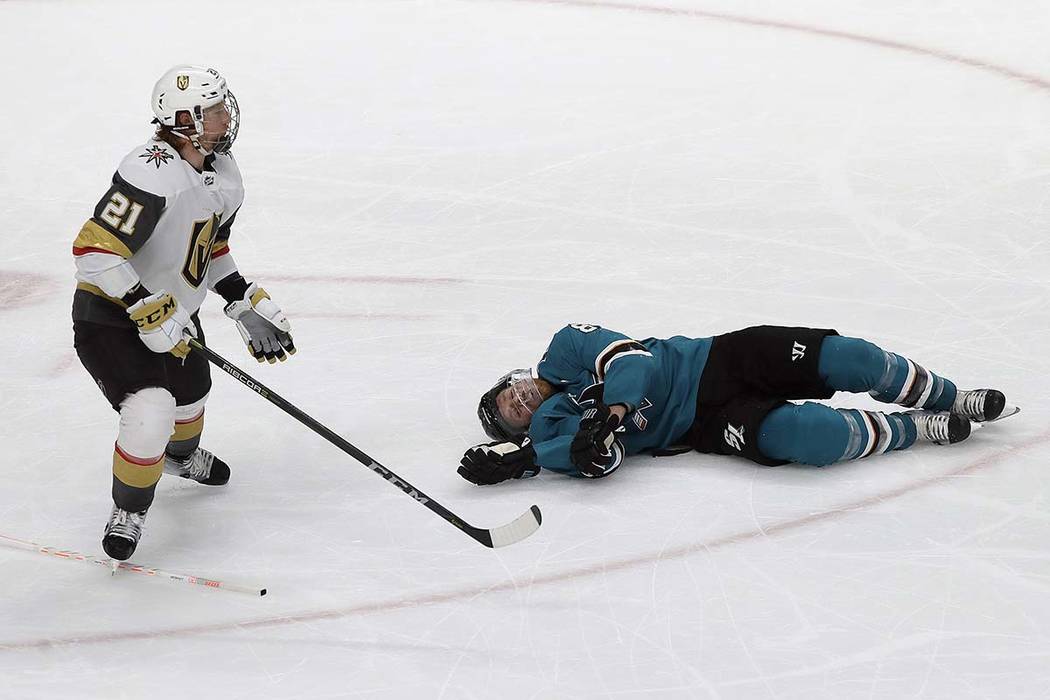NHL alters rulebook to review all major penalties

VANCOUVER, British Columbia — The “Cody Eakin Rule” has been added to the NHL rulebook.
Among a handful of changes approved by the league Thursday, referees will be required to use video review for all major and match penalties beginning in the 2019-2020 season.
Commissioner Gary Bettman also announced an expansion of the coach’s challenge, a new rule for players who lose their helmet during play and several small tweaks to the procedure for faceoffs a day before the first round of the NHL draft.
The changes were finalized during the general managers’ meeting at the JW Marriott Parq Vancouver after being approved by the Board of Governors and the Competition Committee over the past nine days.
“The increased use of video replay is something that we’ve considered and discussed over time, and at this point in time, we think it was the appropriate response to what we were seeing coupled with what we believe is our ability to do it,” Bettman said. “It took a little time to implement the rules to make them work right, and it’s not like it was complaint free.
“Every time you decide you are going to increase the use of technology of video, there are, and the managers will tell you we’ve said this repeatedly, unintended consequences. We think the things that we’re covering are a logical next step that we think we can implement.”
The league was plagued by several high-profile officiating errors during the postseason, including a five-minute major penalty to Golden Knights center Cody Eakin during the third period of Game 7 in the Western Conference quarterfinals.
Eakin cross-checked San Jose Sharks center Joe Pavelski in the chest after a faceoff, and Pavelski was injured after he took an awkward spill and hit his head on the ice. Referees did not initially call a penalty but assessed Eakin a major after a brief discussion.
San Jose scored four goals during the ensuing power play and went on to eliminate the Knights in overtime. The referees from that game did not work for the remainder of the playoffs, and Pavelski later admitted it should not have been a major penalty.
Under the new rule, Eakin almost assuredly would have received a two-minute minor penalty, rather than a five-minute major.
Referees must use video review to confirm all major and match penalties or to reduce the penalty to a minor. Penalties cannot be rescinded altogether.
In addition, all double-minor high-sticking penalties can be confirmed by referees with video review.
“The primary intention there, obviously, is the friendly fire-type offenses where perhaps a player’s own stick or his teammate’s stick causes the injury to the head,” deputy commissioner Bill Daly said. “The official there has the discretion to review it on video to confirm his call or not and will, again, use the tablet or the monitor at the scorer’s bench, not in consultation with the NHL Situation Room.”
The other major change allows coaches to challenge a missed stoppage of play preceding a goal in addition to goaltender interference and offside. This includes hand passes, pucks that hit the spectator netting and pucks played with a high-stick.
The St. Louis Blues lost Game 3 of the Western Conference final to San Jose when Timo Meier’s hand pass led to Erik Karlsson’s overtime goal. In the Eastern Conference semifinals, Artemi Panarin of the Columbus Blue Jackets scored against the Boston Bruins shortly after officials didn’t see the puck hit the protective netting.
Coaches are now permitted to make an unlimited number of challenges. The consequence of a first unsuccessful challenge is a minor penalty for delay of game, and each additional unsuccessful challenge will result in a double-minor.
The Situation Room will continue to be responsible for review in the final minute of regulation and overtime.
“We view this as evolutionary. We don’t want it to be perceived as an overreaction,” Bettman said. “The notion of more coach’s challenges because there are more things that can be looked at is something that we felt needed to be done in terms of giving the coaches more optionality.”
Among the other changes, a player whose helmet comes off during play now must leave the ice.
Line changes for the defensive team no longer are permitted when a goalie freezes the puck on a shot from outside the red line or if a defender unintentionally dislodges the net.
Also, the offensive team will now choose on which side the faceoff will take place following an icing, when the puck goes out of play in the attacking zone and to begin a power play.
Finally, a goal will be awarded if the goaltender deliberately knocks the goal out of place during a breakaway.
More Golden Knights: Follow at reviewjournal.com/GoldenKnights and @HockeyinVegas on Twitter.
Contact David Schoen at dschoen@reviewjournal.com or 702-387-5203. Follow @DavidSchoenLVRJ on Twitter.